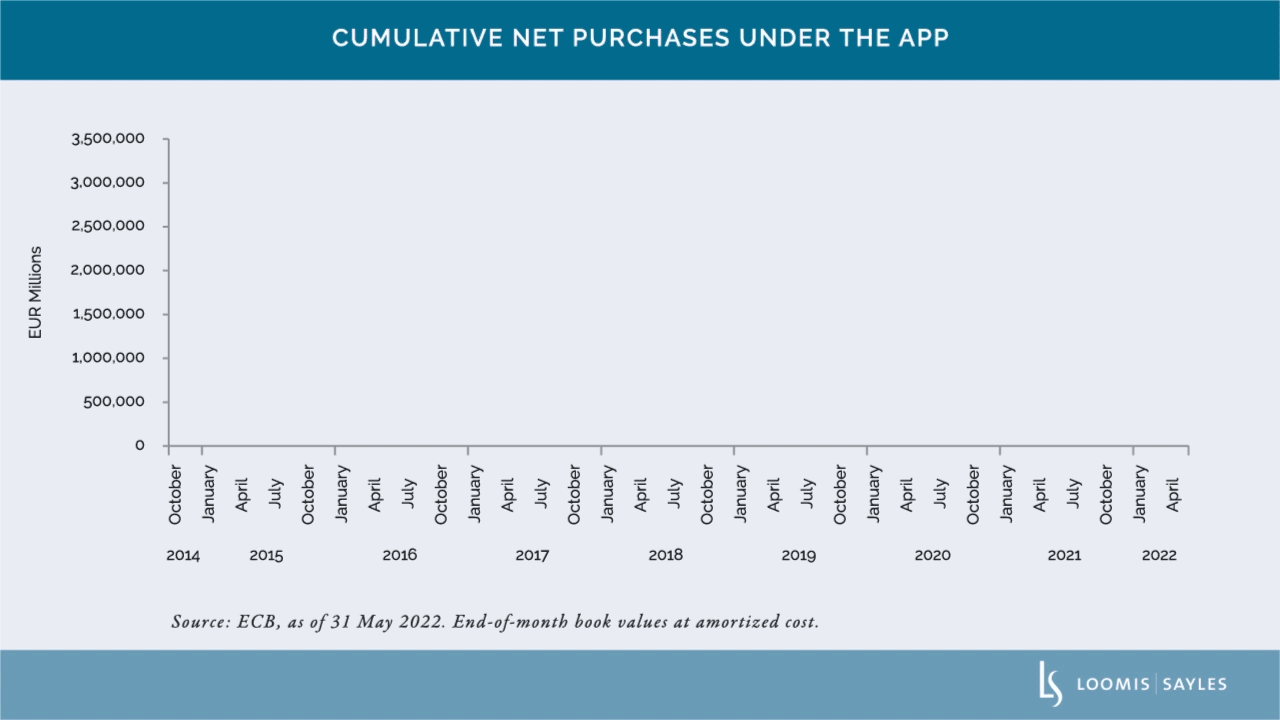Jon, can you bring us up-to-date on recent developments at the European Central Bank (ECB)?
In contrast to any other central bank, the ECB has to take into consideration the varying implications of changes in monetary policy for the 19 countries in the euro zone. Fragmentation risk refers to the potential for monetary conditions to become less consistent across countries, which we believe could harm firms, households and even sovereign financing.
In an ad-hoc meeting on 14 June, the ECB agreed to create an anti-fragmentation tool—no further details yet, as this will take some time. The central bank statement indicated the ECB will immediately start using Pandemic Emergency Purchase Programme (PEPP) reinvestments to counter fragmentation. PEPP reinvestments may not be enough and existing holdings might not mature when funds are needed. However, the day before the ad-hoc meeting, ECB board member Isabel Schnabel made a crucial comment, stating there would be ‘’no limits’’ to the ECB’s commitment. The structure of the new tool will be carefully worked out, but from our perspective, Schnabel’s comments suggest potential opportunity where there was evidence of fragmentation.
How do you think the new tool might work?
 We would expect the new tool to retain the flexibility of the PEPP (i.e., vary across asset classes and countries). Re-financing operations may also play a role in addressing fragmentation, but we believe those would most likely be separate from any asset purchase tool.
We would expect the new tool to retain the flexibility of the PEPP (i.e., vary across asset classes and countries). Re-financing operations may also play a role in addressing fragmentation, but we believe those would most likely be separate from any asset purchase tool.
We don’t expect an upfront amount associated with the tool, but we don’t rule it out either since the ECB did state an amount with PEPP. We think the central bank may wish to get away from pre-committing amounts. This new tool, unlike PEPP and the Asset Purchase Programme (APP), will not have the core function of combatting too-low inflation, and therefore it does not rely on a stock effect (amount of assets purchased).
The ECB may wish to make determinations internally as to where it sees evidence of fragmentation, and how best to address it—and then make any asset purchases accordingly (or offer ad-hoc refi operations).

How do you think the central bank will proceed?
We wouldn’t expect a clear statement of the optimal spread levels the ECB hopes to achieve. Schnabel was clear that some sovereign spread moves are to be expected as they reflect fundamental conditions, such as debt levels or fiscal policy. But fragmentation concerns could present if spreads widen due to exogenous drivers. Fragmentation concerns are also likely to arise when firms see different funding costs because of where they are located – not their particular credit profile.

The ECB will soon face a question of when and at what pace to allow the APP to run off (it could even consider sales). This decision could be linked with the new tool. Allowing APP run-off while the new tool is operating could offset any balance sheet expansion resulting from anti-fragmentation purchases. Such purchases may also create an easier environment in which to let APP run off, as the market will worry less about the impact on sovereign spreads of a shrinking balance sheet – which might be considered quantitative tightening (or at least the absence of easing).
Bottom line?
In sum, we think the ECB wants strategic ambiguity; fragmentation is evident and a clear issue in financing conditions, not just sovereign spreads. Balance sheet neutrality is feasible, and probably desirable.
We also expect an eventual dovetailing of reinvestments, and potentially anti-fragmentation measures, with climate strategy. We think we will see the strong influence of PEPP in terms of flexibility - but a significant differentiation from APP, which was solely a low-inflation era tool.

MALR029178



 We would expect the new tool to retain the flexibility of the PEPP (i.e., vary across asset classes and countries). Re-financing operations may also play a role in addressing fragmentation, but we believe those would most likely be separate from any asset purchase tool.
We would expect the new tool to retain the flexibility of the PEPP (i.e., vary across asset classes and countries). Re-financing operations may also play a role in addressing fragmentation, but we believe those would most likely be separate from any asset purchase tool.


